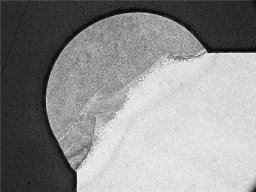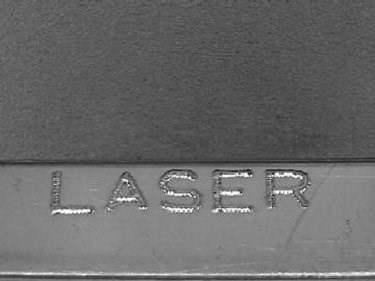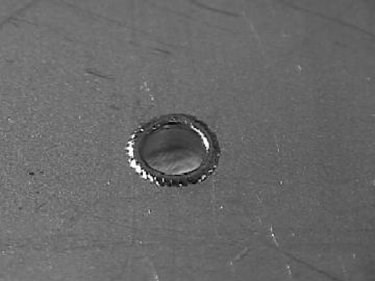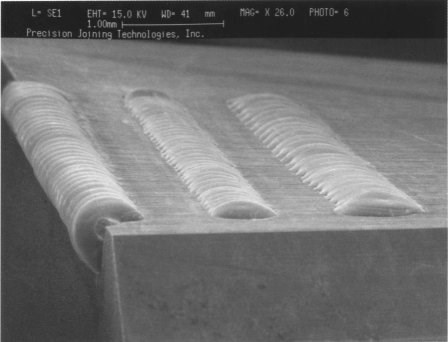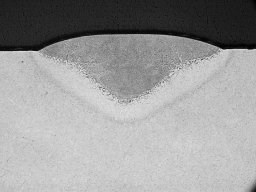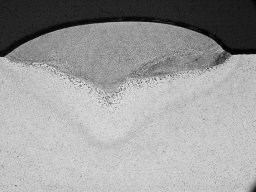Laser Weld Repair of Molds
A nuclear weapons welding process is used to repair molds for the plastic injection mold industry.
Since the 1970s, the nuclear weapons industry has used the pulsed neodymium-yttrium-aluminum-garnet (Nd:YAG) laser welding process for the joining of intricate/heat-sensitive components. The characteristically high-power density of this process yields the lowest heat input fusion welding process available to the industry. Today, this technology is being used to repair molds.
The mold repair work was initiated with the question, "Do you think you could repair mold steels using the laser and some filler material?" The answer, "No problem with a supply of small-diameter filler wire and years of adding filler materials to enhance the weldability of weapon component materials."
The mold industry readily has accepted this process and, in the past five years, more than 3,500 molds have been successfully repaired for mold shops throughout the country. Two multipulsed, fully-automated CNC lasers with four-axis motion systems and two single-pulsed manual laser systems are used for the laser weld repair of molds.
Pulsed Nd:YAG Laser Welding Process Laser weld mold repair is accomplished by the addition/placement of filler material between the worn/damaged mold surface to be repaired and the laser beam, which melts the filler material with the mold material - yielding a built-up surface that is slightly higher than the original part dimensions. The addition of filler material can be done both manually and automatically.
Manually, the wire is held by hand in intimate contact with the mold material to be built up. This is a relatively slow but very effective process. The skill level required for manual repair varies considerably depending on the application.
Automatically, an automated filler wire feed system integrated with one of the automated pulsed Nd:YAG laser welding systems - which greatly enhances welding speed and weld consistency for mold repair - is used in this process. This system was developed in the mid-1980s for the purpose of adding filler material with the Nd:YAG pulsed welding process to enhance the weldability of difficult-to-weld alloys, which make up some of the nuclear weapon components. Wire diameters from 0.010 in. to 0.020 in. have been used with the automated filler wire feed system for mold repair. The skill level of the welding operator now is reduced dramatically with the use of the automated filler wire feed system, and welding speed is greatly increased.
A photograph of the typical laser weld build-up on a 420 SS mold material is shown in Figure 1. The left side weld shows the build-up of the corner of the mold material. The middle weld shows the build-up on the top surface using a 0.010-inch diameter filler wire. The right side weld shows the build-up on the top surface using a 0.015-inch diameter filler wire.
Figures 2, 3 and 4 show metallographic cross-sections of the three welds in Figure 1. Figure 2 shows the corner weld build-up. Note how enough filler material has been added to allow for re-establishment of the corner of the mold. This is the most utilized application for laser weld repair of molds. Figure 3 shows the build-up from the 0.010-inch diameter wire. The weld measures 0.030 in. in width and extends 0.0024 in. above the top surface of the mold. Figure 4 shows the build-up from the 0.015-inch filler wire. Increased laser energy/pulse was used for the larger wire and thus the weld is wider at 0.036 in. and - because of the larger mass of wire used - extends 0.0056 in. above the top surface of the mold.
Repair Locations on the Mold
The laser light impinges on the mold repair area through line of sight. Thus, as long as you can see the repair area, it can be repaired with the laser. As mentioned previously, the most utilized application is the repair of corners - including both outside and inside corners. Other typical applications include the build-up of mismarked engraving on the mold. Figure 5 shows the build-up of the characters "LASER" using a 0.010-in. diameter filler wire.
A variation of the build-up of a corner is shown in Figure 6. The inside diameter of an 1/8-in. hole has been built up. The repair depth on the 1/8-in. hole is approximately 0.030 in. from the top surface.
Special optics/techniques are required for the difficult-to-see locations. Some repair locations only can be repaired with the laser when access to the repair area is restricted because of size constraints.
Filler Wire Size
The selection process for the size of filler wire to be used depends on the following:
- Thickness of the mold area to be repaired.
- Volume of material necessary to build up the repair area.
The filler wire sizes used may vary from 0.003 in. to 0.020 in. in diameter. The smaller diameter wires must be used to minimize the laser energy/pulse and thus minimize heat input when the lowest possible distortion of the repair area is required. The larger wires are used when the repair area is relatively large and the thickness of the repair area is increased.
Filler Wire Type
The selection of the filler wire type depends on the following:
- Type of mold material being repaired.
- Hardness requirements of the resultant weld metal.
- Condition of the repair area: Are platings present? Is it a crack being repaired? Is this a previously welded area?
- Analysis of what caused the damage on the mold.
Hardness of the Resultant Weld Metal
The hardness of the resultant weld metal varies depending on the following:
- Mold material being repaired.
- Type of filler material used.
- Laser parameter selection, which influences the dilution of the filler material with the base mold material.
Hardness data has been obtained for a variety of base mold material/filler wire type combinations - the mold base materials analyzed include S-7, H-13, P-20 and 420 SS.
Mold Materials Successfully Repaired
The following materials have been successfully laser weld repaired: S-7, H-13, P-20, NAK-55, D2, A2, A6, M2, 410 SS, 420 SS, 440 SS, Elmax, Aermet, CPM9V, aluminum alloys, copper beryllium and amcoloy 940.
Mold materials are complicated materials to effectively weld with any welding process. A welding metallurgy engineering background is a necessity in understanding how these base materials interact with the heat of welding and the type of filler material used. The more that the material interaction is understood, the lower the chance of future damage/failure in the repair area.
In particular, cracking of the weld must be avoided. Cracks in these relatively hard materials can propagate rapidly, leading to failure of the part. The use of the wrong filler material or improper welding techniques easily can lead to cracking in the weld. Metallographical analysis for the different filler wire/base material combinations and thorough visual inspection should be completed. In general, the higher the carbon content, the higher the crack sensitivity in the weld.
Aluminum and copper alloy materials pose an interesting challenge for laser weld repair because of the high inherent reflectivity of these materials to the 1.06-micron Nd:YAG laser light. Special techniques have been developed for the repair of these alloy types.
Process Advantages
When compared with other welding processes, laser welding has the following advantages:
- No undercut/sink of the weld or base metal surrounding the welded area when proper techniques have been used.
- Minimal heat input to the mold base metal resulting in no or the lowest possible distortion to precision features in close proximity to the weld repair area.
- Minimal weld metal deposited resulting in minimal machining to restore the part to its original dimensions.
- Hard, tough resultant weld metal attributable to the fine grain structure of the weld metal, which is a result of the extremely rapid solidification of the laser weld.
- Extremely precise control of the weld metal location, which allows for welding within a few thousands of an inch of features that are not to be disturbed on the mold.
- Little to no discoloration of the weld and the surrounding base material.
Laser Equipment Safety
The laser equipment can be very hazardous. The high voltages present in the laser power supply and the laser cavity are lethal. Only trained personnel should be allowed to repair the laser equipment. The laser light can cause permanent damage to the eye - the collimated nature of the laser light allows for focusing of the light on the retina in the eye. Direct laser light or scattered laser light allowed to enter the eye can cause partial to total permanent blindness. A laser safety program should be initiated and laser safety training should be given to all individuals before using any laser welding system.
Related Content
Questions and Considerations Before Sending Your Mold Out for Service
Communication is essential for proper polishing, hot runner manifold cleaning, mold repair, laser engraving and laser welding services.
Read MorePrecision Meets Innovation at IMTS 2024
After attending IMTS, it's clear that the integration of advanced technologies is ready to enhance precision, efficiency and automation in mold manufacturing processes. It’s a massive event, so here’s a glimpse of what the MMT team experienced firsthand.
Read MoreHow to Overcome Complex Mold Texturing Problems
Key benefits when considering laser technology for mold texturing and repair.
Read MoreLaser Welding Versus Micro Welding
The latest battle in finely detailed restoration/repair of mold materials.
Read MoreRead Next
Reasons to Use Fiber Lasers for Mold Cleaning
Fiber lasers offer a simplicity, speed, control and portability, minimizing mold cleaning risks.
Read MoreHow to Use Continuing Education to Remain Competitive in Moldmaking
Continued training helps moldmakers make tooling decisions and properly use the latest cutting tool to efficiently machine high-quality molds.
Read More


